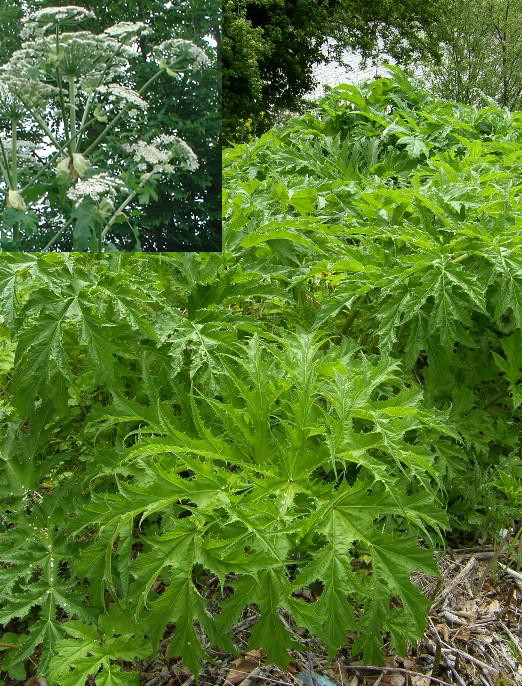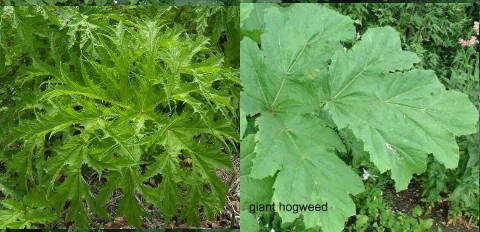Giant HogweedScientific Name: Heracleum mantegazzianum |
This spectacular plant which is a member of the Umbellifer Family, was introduced to Britain from the Ural Mountain region by Victorian gardeners, but unfortunately it is now widespread in the wild and causes a number of problems. The stems contain copious amounts of clear watery sap which reacts with melanin in the skin removing its protection making it very sensitive to sunlight. On contact the skin can become broken and blistered - it can cause temporary blindness if it gets into the eye. The leisons appear some hours after contact, heal slowly and can leave the affected skin permanently sensitised to sunlight - Phytophotodermatitis. Brushing against the plant can cause the same reaction due to the presence of fine hairs.
It is also a threat to native plants as it colonises riverbanks and other disturbed ground in dense stands blocking out light with its large leaves.It is a perennial which dies away in the late autumn and comes into growth the following spring. The hollow stems can be 10 cm thick and carry the plant to a height of 3 to 5 metres. They have numerous purple blotches and fine hairs concentrated around the bases of the leaf stalks. The leaves are compound with 3 deeply lobed leaflets and the lower ones can be up to 1.5 m across on a long, hollow, spiny stalk. There can be some variation with some plants having more finely cut leaves than others, as seen in the two lower pictures.
The small, white flowers are carried on flat, umbels with more than 50 branches (rays) and develop eliptical seed which are 7 to 12 mm long. A single flower head can produce 1500 seed and they can remain viable in the soil for 7 to 8 years.
There is a large tap root so digging out a mature plant requires some effort, but is the quickest way to remove it. Protective waterproof clothing, gloves and a face visor must be worn when working in close proximity to the material - it is also advisable to have a supply of water and an eyewash nearby to treat any splases of the sap.
If the plant has cast seed in previous years there may be new plants germinating for several years, so vigilance is required to remove them. They are usually within a 4 metre radius, but can be carried further by water courses
Spraying with a systemic weedkiller such as Glyphosate, can be carried out between March and August, but before the plant produces seed, any flowers should be removed. Any regrowth or seedlings which germinate later can be sprayed as well.Under the 1981 Wildlife and Countryside Act/ Wildlife (Northern Ireland) Order 1985, it is an offence in the UK to allow it to grow in the wild. Plant material can be kept on site, allowed to dry out and burnt, otherwise to dispose of it or soil contaminated with it, requires a certificate for Waste Transfer and to be taken to a suitably licensed landfill site.
It is important to distinguish Giant Hogweed and Common Hogweed which has long been used for culinary and some medicinal purposes.

